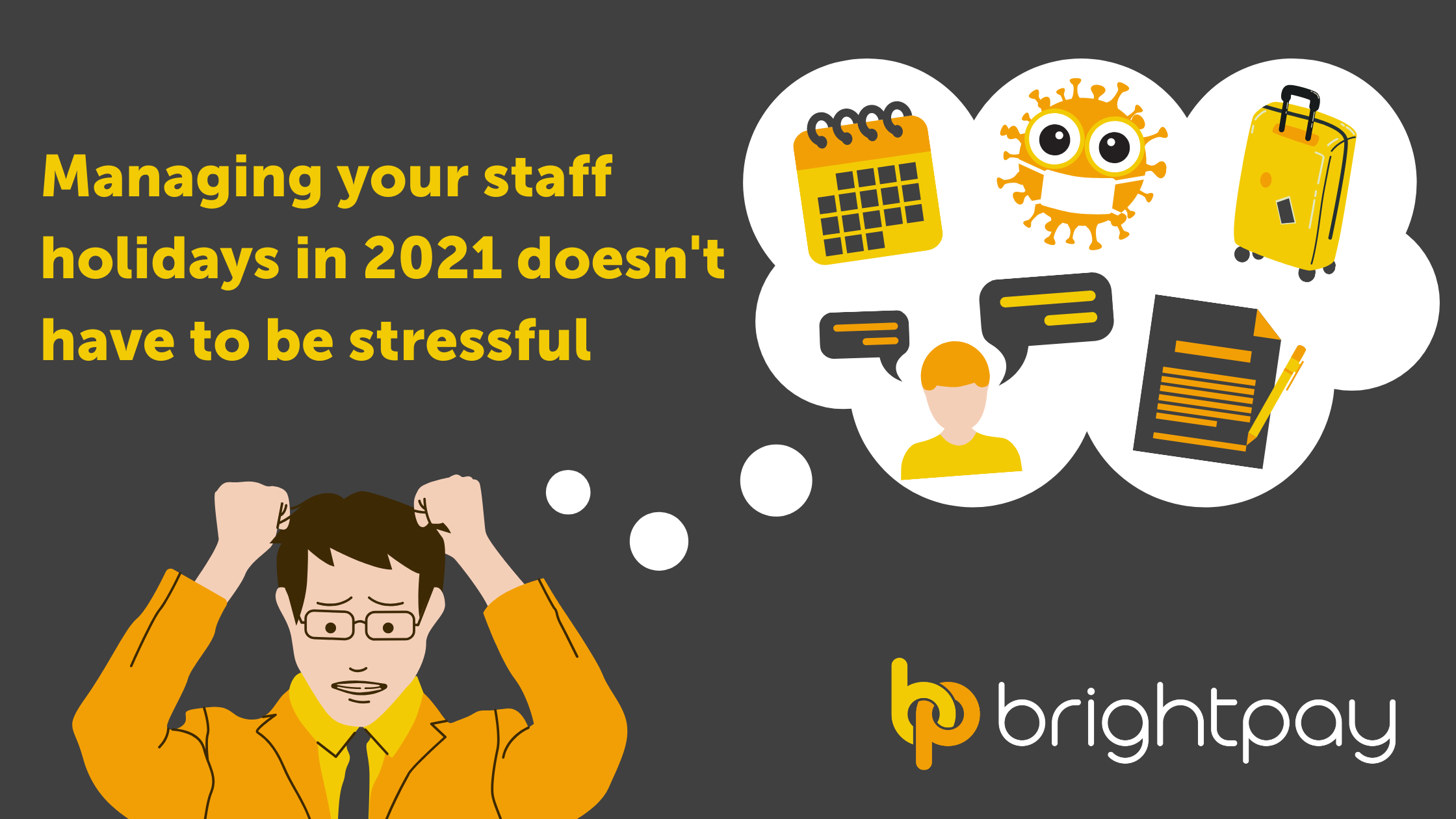Aug 2022
2
Weather alert: How to handle last-minute annual leave requests

Phew, what a summer we’ve been having! From barbeques to beach days, it’s no wonder staff have been booking days off last-minute to soak up the sun. However, this can lead to businesses becoming short-staffed, which can put a strain on your usual workflow. With more staff taking annual leave, it can also often lead to you spending more time on payroll. You’re a business owner, not a juggler, so how does one handle last-minute holiday requests, every time the sun comes out? Here are our top 3 tips and tools from the payroll industry.
1. Take your annual leave management online
Rather than receiving annual leave requests via letters, phone calls or emails, why not get a software that manages the whole process for you? For example, employee apps are becoming increasingly popular, and with good reason. With an employee app, you can let employees book annual leave themselves, from a few simple taps on their phone. This means your employees can submit annual leave requests from anywhere, at any time.
You, as the employer, will then be notified of this request and can sign into your employer portal from a browser, where you can accept or reject the requests, at the click of a button. This can be done whether you’re on your desktop in the office, or your tablet at the beach – perfect for those last-minute leave requests!
This not only streamlines and automates your annual leave management process, it also makes your business much more tech savvy, improves employee job satisfaction, and aligns more with hybrid and remote working models.
2. Automatically sync employee annual leave to your payroll software
Adjusting payroll files last-minute can be exhausting, especially during busy holiday periods. However, using a payroll software that can automatically sync your employees’ annual leave data back to the payroll software, can save you a significant amount of time, each pay period.
For example, our cloud extension, Bright Pay Connect, syncs all of the data from our annual leave management tool, directly back to the payroll software. This means that all of your employees’ leave data will be up-to-date in the payroll software while you’re using it. This reduces the likelihood of errors on payslips, saving you time rectifying any errors that can crop up from mismanaged annual leave.
3. Get an online company calendar
Having an online companywide calendar lets you view your entire company’s leave (annual leave, maternity leave, sick leave, etc.) from your browser, on any device. This means that when you’re deciding whether to accept or reject a last-minute annual leave request, you can quickly pop onto your online company calendar to see who else might be booked off on those selected dates.
Having an online company calendar also allows you recognise patterns in staff’s annual leave bookings. For example, John might have taken annual leave the past four Mondays in a row, Frank could be unknowingly taking every second Friday off, while Mary doesn’t seem to have taken any leave in the past 10 months. This lets you keep a closer eye on your staff’s time off, and lets you make more strategic and well-rounded decisions for your business.
Summer isn’t over, and neither are last-minute leave requests
As you can see, annual leave management really has never been easier. All of the features mentioned above are available in our cloud extension, BrightPay Connect. If you’re interested in learning more about BrightPay Connect, why not book a free 15-minute demo, where we can show you even more ways our cloud extension can benefit your business.
New to BrightPay? BrightPay is one of the UK’s leading payroll software providers for small businesses, and is award-winning payroll software. Download our completely free of charge 60-day trial, with full functionality.
Want to stay in the loop of all things payroll? Keep up-to-date on all the latest payroll trends, news and legislative updates in our weekly newsletter.
Jun 2022
1
To Pay or Not to Pay – The Jubilee Bank Holiday
On Friday 3 June 2022, there will be an extra Bank Holiday granted to celebrate the Queen’s Platinum Jubilee. The usual May Bank Holiday has been moved forward to Thursday 2 June 2022 resulting in a four-day weekend for those able to take time off.
What are your employees’ rights when an additional Bank Holiday is announced?
The general rule is that employees do not have an automatic right to a day off work when this or any other Bank Holiday is announced. Employers will need to review their contract of employment to determine if an employee is entitled to a day off work and to be paid for it.
Some contracts of employment will state that the employee is entitled to a certain number of days of annual leave, “plus bank holidays”. In this case, they will be entitled to the additional Bank Holiday off work.
Other contracts of employment state that the employee is entitled to a set number of days of annual leave, but do not mention Bank Holidays. In this scenario, the employee will not be automatically entitled to the additional Bank Holiday off work.
Some employment contracts provide the employee with a set number of days of annual leave “plus eight Bank Holidays”. Again, this will mean that the employee is not automatically entitled to the additional Bank Holiday off work.
If the contract states “you are entitled to XX days holidays plus the usual bank holidays in England and Wales” again this would not give the worker an automatic right to the additional Bank Holiday because the addition Jubilee day is not a “usual” bank holiday
Employers will need to review their employees’ contracts of employment to see whether all of them, some of them, or none of them are entitled to take the Platinum Jubilee Bank Holiday off of work.
Where employees do not have a contractual right to the additional Bank Holiday, employers will need to consider if they wish to grant the day’s leave as a gesture of goodwill, if they will require employees to attend work or if they will give employees a day off in lieu of the Bank Holiday due to staffing requirements.
Whilst it is important to comply with the letter of the contract of employment or work, the additional Bank Holiday can also be a morale booster for staff. You may consider granting employees an additional day’s holiday for the Jubilee as an act of goodwill, stressing of course the reason for it being allowed as a one-off gesture.
Related Articles:
Extra Bank Holiday for Queen's Jubilee
May 2022
24
Streamline your business' annual leave management
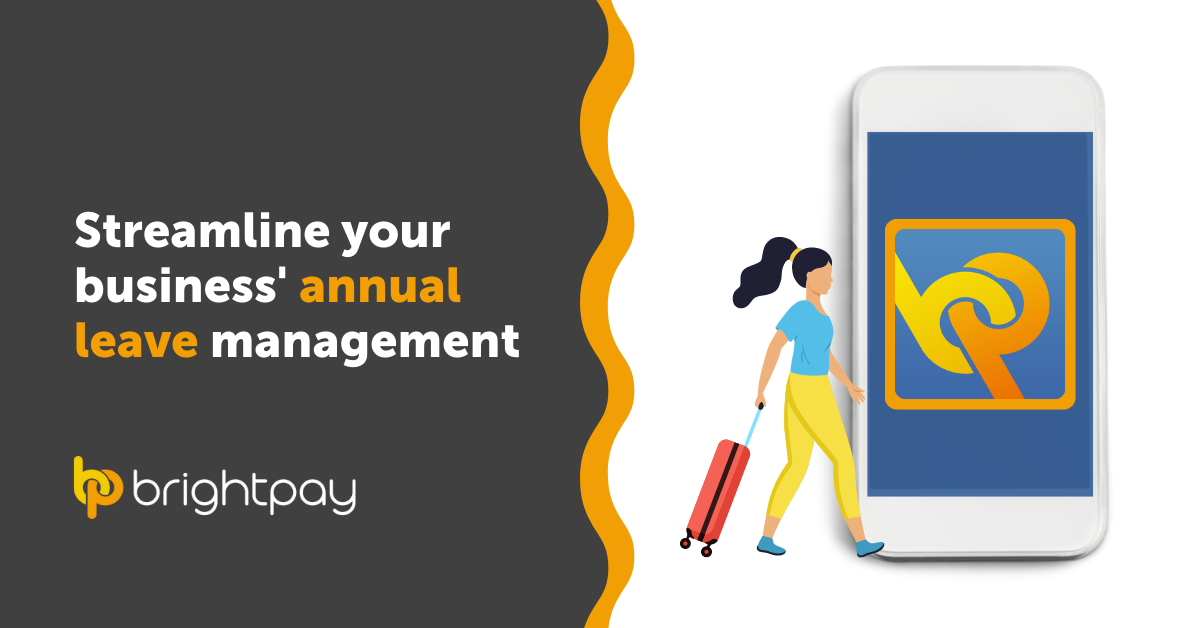
Managing employees’ annual leave can be a stressful process. For you as the employer, having email or even paper requests sent from multiple locations can be frustrating, especially during busy holiday periods. Likewise, employees having their leave rejected because of double bookings or mismanagement can sometimes sour working relationships. An inefficient annual leave system can also make managing and tracking payroll to become more difficult.
Having a system in place that can automate these tedious aspects of annual leave management can improve your working relationships with employees, as well as increasing their job satisfaction levels.
Move your employees’ annual leave to a secure online portal
It’s time for your employees to say goodbye to printed letters, excel spreadsheets and long email threads to book annual leave. While these more traditional methods can be still used, they’re becoming less and less reliable, and there are more effective alternatives to take their place.
Moving annual leave management to a secure online portal offers many benefits for your business, including:
- Saving time chasing annual leave requests
- Reducing stress with a more automated system in place
- Eliminating errors that can occur from more traditional methods
- Increasing employee satisfaction by reducing mismanagement
- Creates a fair system where all requests are timestamped, so staff can be accepted on a first come, first served basis
- Reducing admin workload from rectifying mistakes and retrieving lost emails
- Promoting environmental sustainability by turning annual leave into a completely paperless process
Using BrightPay’s cloud extension, BrightPay Connect, automates the entire annual leave process for you. Our employee self-service app allows staff to request annual leave through an easy-to-use calendar format on their smartphone or tablet device, where you will then receive a notification on your own employer dashboard. From here, you can view the company calendar through the same and choose to either approve or reject employees’ requests. Managing annual leave has never been so easy!
Our cloud extension comes with a host of other benefits to increase your service offering, such as:
- Client payroll approval feature that gives your clients more control over their payroll by allowing them to make any necessary changes and approve the payroll before it is finalised and before payslips are distributed.
- Automatic cloud backups of your payroll data that ensure your clients’ data is safe and secure at all times. This also aligns with GDPR best practices.
- Remote working support by notifying you when someone else has worked on an employer’s file from a different computer, and if they are still working on that file.
- Bureau branding giving clients a more personal touch to your services, enhancing work relationships.
Interested learning more about BrightPay Connect? Sign up for a free 15-minute demo. Interested in staying up to date on all the latest payroll trends and legislative changes? Sign up to our newsletter below for weekly emails so you can stay in the loop.
Jun 2021
3
The key to managing the annual leave backlog
Managers will likely be in a situation where many employees will request to take leave at the same time. Whether it’s during the summer months, winter months or during school holidays, there will be a higher demand for leave at certain times of the year. But how do you handle it?
Employers should have a clear policy on holiday requests. Typically, a “first-come, first-served” approach works well. While it might not be possible to please everyone and give them their requested time off, it is important that you deal with annual leave requests in a way that is transparent and fair to all employees.
With the average annual leave in the UK at approximately 28 days per year, a recent Glassdoor Annual Leave Survey revealed that the average UK employee only uses 77% of their annual leave per year. To achieve a better work-life balance, employers should encourage employees to take their full annual leave days every year to avoid burn out further down the line.
Where possible, managers should allow and accept the annual leave requested. However, managers have the right to decline holiday requests (with the correct notice) if the timing of leave would result in the business being understaffed and unmanageable.
If your business is faced with a high demand for annual leave for certain time periods every year, you can require employees to take annual leave on dates chosen by the employer. Employers must give the employee twice as many days’ notice as the period of leave requested.
By introducing BrightPay Connect, employees can access a self-service portal via an app on their smartphone or tablet device. They will be able to request leave 24/7 from anywhere, meaning they don’t need to be in the workplace to request leave. When an employee requests leave, the employer will get a notification to login to their online portal to approve or reject the leave. The requests will be time stamped so you can see the order in which they come in. Employers can access a company-wide calendar that will display all leave so that you can ensure adequate staffing before approving an annual leave request.
You can have multiple users on BrightPay Connect meaning each department/line manager can approve leave for their own department. More information on user access and permissions can be found here.
Book a 10-minute online demo of BrightPay Connect to discover how it can benefit your business.
Related articles:
May 2021
21
What are the biggest GDPR advantages of BrightPay Connect?
BrightPay Connect is an online payroll and HR tool that offers significant benefits to help your business comply with the GDPR legislation. BrightPay Connect is an add-on to BrightPay on your PC or Mac that introduces powerful new features. The main objective of BrightPay Connect is to increase the efficiency and effectiveness of payroll work to keep in line with the GDPR guidelines by linking your payroll data to the cloud to enable new features.
Automatic Cloud Backup
Are you keeping your payroll files safe and protected? It is important to keep them protected in case of the event of fire, theft, cyber-attacks and damaged computers. BrightPay Connect is the solution. When you link an employer to BrightPay Connect, it will be automatically synchronised to the cloud as you run your payroll or make any changes. It is hosted on Microsoft Azure for ultimate performance and reliability. BrightPay Connect keeps a chronological history of all backups which can be restored at any time.
Employee Self-Service Portal
Are you trying to find ways to improve your time-management skills? You can invite employees to their own self-service online portal which can be accessed using a smartphone app or any web browser. Employees will be able to securely access and download payslips, P60s, P45s, submit annual leave requests and view leave taken and leave remaining and also view the personal details you currently hold for them, and request to make updates such as change of address, etc.
Bureau / Employer Dashboard
Are you looking for an easy and secure way to share documents? BrightPay Connect provides a self-service dashboard to both accountants and employers so they can access payslips, payroll reports, amounts due to HMRC, annual leave requests and employee contact details. You can also securely share resources, upload HR documents and get payroll data approval from the client electronically.
No Conflicting Payroll Copies
BrightPay Connect includes improved remote working functionality, including a ‘version checking’ feature when opening an employer, and an ‘other users check’ when opening an employer to prevent the risk of conflicting copies.
Two Factor Authentication
Two Factor Authentication is a second layer of protection to re-confirm the identity for users logging into Connect through an internet browser or through BrightPay. This improves security, protects against fraud and lowers the risk of GDPR data breaches as users can access sensitive employer and employee data in Connect with the increased security layer. Click here to find out more about how this feature works.
Data Input
Bright Pay Connect allows users to securely send payroll entry requests and payroll approval requests to their clients, changing the way payroll bureaus interact and communicate with clients. Once the hours are added/imported, information can be automatically synchronised to the employer file. Bureaus can then securely send a payroll summary back to the client for approval through BrightPay Connect. This will eliminate the need to exchange emails, reduce the double entry requirement and minimise errors from manual data input. Inputting data through BrightPay Connect’s secure portal will help with GDPR compliance.
Additionally, there is an audit trail of the requests being approved by the client. The audit trail includes each of the steps taken by your client and includes payroll files approved and submitted by the client.
HR & Annual Leave Management
BrightPay Connect also includes an employee calendar, which can keep record of all employees past and future leave including annual leave, unpaid leave, absence leave, sick leave and parenting leave. Employers can upload sensitive HR documents such as contracts of employment.
24/7 Online Access
Do you want to be in control at anytime and anywhere? BrightPay Connect allows mobile and online access at any time of the day. This fulfils the GDPR best practice recommendation to provide remote access to a secure system where individuals have direct access to their personal payroll data.
If you are interested in BrightPay Connect, why not attend one of our free online demos!
Related articles:
- The Key to Keeping in Touch with Employees while Working from Home
- 10 Benefits of using a Cloud Payroll Portal to Manage Employees Annual Leave
- The key to getting payroll information from your clients on time
- 3 Benefits of Employee Apps That You Never Knew
May 2021
11
Leaving lockdown: How to manage the annual leave backlog
Employers are well used to staff wanting to take holidays at the same time. It is inevitable that certain times of year like Easter or Christmas will be more popular than others. As we remain in lockdown, most employees will want to save their time off for when restrictions are lifted. Last year, key workers who did not get to take all their statutory annual leave entitlement due to COVID-19 were allowed carry over up to four weeks of unused holidays into the next two years. While this flexibility was necessary to protect workers' rights, it has caused an annual leave backlog that could become a real nightmare for employers to manage.
While we know that “nothing can be guaranteed”, we cannot help but feel optimistic about Boris Johnson’s tentative plan to ease all lockdown restrictions on June 21st, 2021. There is even an online petition asking the government to make June 21st, 2021 a one-off Bank Holiday, to be known as Merriweather Day, as an opportunity for families and friends to come together. Once this date was announced there was a huge scramble in workplaces for employees to get their requests in to have the week of June 21st off. While it might not be possible to please everyone and give them this time off, it is important that you deal with annual leave requests in a way which is transparent and fair.
Some employers are choosing to force staff to take holidays at a time that better suits the business. While some employees may be perfectly happy with these tactics being enforced, many others will feel hard done by that they do not have any control over the dates that they take off. Offering to buy back employees’ holiday days that are in excess of the statutory minimum is another method that is being used, however, this could end up being expensive and hard to manage for employers. So, what is the best option for all parties involved?
An employee app that manages staff holidays
BrightPay Connect, an optional add-on to BrightPay’s payroll software, is the simplest way to manage your staff's annual leave – headache free. BrightPay Connect streamlines leave requests and leave approval. This is how it works:
- The employee requests leave from the calendar in their BrightPay Connect mobile app or from their PC or tablet. This means employees can request leave anytime, anywhere.
- The employer (or the person who has been assigned to oversee the management of that employee’s annual leave) is notified of the request on the dashboard of their own BrightPay Connect account.
- The employer/manager can then either approve or deny the request at the click of a button.
- The employee will receive a notification on their device informing them of whether their request has been approved or denied.
The most popular policy of granting annual leave is on a first come, first served basis. While this policy is the most fair; depending on the system in place, it can still be difficult to keep track of which employee requested the leave first. With BrightPay Connect, you don’t have that problem as you will be able to see the order in which requests come in. Employees also have the ability to request half days or request to cancel leave that has already been granted.
In the employer’s dashboard, from the calendar tab, the employer can view a real time, company-wide calendar. At a glance, employers see which employees are on leave and the type of leave. This is especially handy nowadays when staff may be working from home and it is hard to keep track of who is off and who is not. Cloud integration means any approved leave requests will flow directly back to your BrightPay payroll software on your PC or Mac.
Using BrightPay Connect to manage employee’s leave means less conflict in the workplace and less stress all round. Book a free demo today to find out the many other ways BrightPay Connect can improve employer/employee relationships.
Register for our upcoming free webinar where we will discuss preparing for the safe return to the workplace, the furlough wind-down, redundancies and vaccine policies.
Download our free whitepaper on tips for managing employees as lockdown ends. The guide includes: important HR tips and best practices as we approach the return to workplaces. Plus, our team of employment law experts reveal what you should avoid: https://t.co/Fwm24GNpob #payroll pic.twitter.com/obedP7QG1l
— BrightPay UK (@BrightPayUK) April 27, 2021
Related articles:
Dec 2020
11
Furlough and holiday during the Christmas period
Can you believe there are only two more Saturdays until Christmas?! I for one am in full on festive mode. My tree is up, the baubles strategically placed on top and out of my cat’s reach, and I’ve been blasting my ‘Xmas Hits’ playlist at full volume throughout my apartment, much to the chagrin of my long-suffering partner. It feels like a well deserved holiday at the end of a very crap year and even more well deserved time off.
But this Christmas has posed a new problem for the world of payroll - what happens with furloughed employees, especially as many would normally take Christmas and New Year’s as annual leave? Can they be furloughed for this period?
Where a bank holiday (namely Christmas Day, Boxing Day and New Year’s Day) falls inside an employee’s period of furlough and that employee would have normally worked this bank holiday anyway, then their furlough will be unaffected. However, if the employee would normally have taken these days as part of their annual leave then you, as the employer, have two options:
a) They can take the bank holiday as leave - If the employee does take the bank holiday as annual leave whilst on furlough then holiday pay must be paid instead.
b) They defer the bank holiday - if the employee doesn’t take the bank holiday as annual leave then this must be deferred as the employee will still be entitled to these days as leave. So they can take them at a later date.
So what happens with holiday leave during furlough then? Furloughed employees still continue to accrue annual leave entitlement as per employment law. Employees can agree to vary their holiday entitlement with their employers as part of their furlough agreement but workers are still entitled to a minimum of 5.6 weeks of statutory paid annual leave each year. This is non-negotiable.
Employees can still take holidays whilst on furlough though if they are being flexibly furloughed then any hours they take as holiday during the claim period should be counted as furloughed hours and not working hours. You should not place employees on furlough just because they’re going to be on paid leave or because you usually do less business over the festive period. (However, if you expect your business to be shut down completely or to be severely affected over the 2 week period due to the pandemic then you can of course still claim under the Coronavirus Job Retention Scheme).
A nice succinct summary of this I read online reads as follows:
“If you were going to furlough [employees] anyway then there is nothing to stop you doing it whilst they are on (pre-booked) holiday, or forcing them to take holiday (provided you give them adequate notice). If, however, you are 'furloughing' them because they've booked a couple of weeks off, then you are abusing the system and do not have a valid claim.”
This does mean that you will have to pay the employee’s holiday pay at the normal rate of pay and will be required to pay employees who are on holiday additional amounts over the grant to make up their usual holiday pay. If an employee usually works bank holidays then you can agree that this is included in the grant payment.
Whew! So a lot to digest but I hope that helps to clear things up a little bit. But as always, if in doubt please check the full guidance on the HMRC website. And once that’s all sorted, get your tinsel headdress on, pop open the mulled wine and start looking forward to the coming festivities!
Sep 2020
22
Managing Annual Leave During COVID-19: 3 Tips Every HR Manager Needs To Know
COVID-19 has thrown many curveballs for businesses of every size and industry across the United Kingdom. Employers are finding themselves in situations that they could never have expected and faced with challenges that nobody saw coming. However, life must go on and business owners are forced to find creative solutions to overcome these challenges and ensure the continued growth of their businesses.
One of the most common challenges facing employers right now is related to annual leave. Of course, many employees across the country have been placed on furlough for some time in 2020 and many are still on furlough today. However, this doesn’t mean that they are not entitled to annual leave, or that their employee rights no longer apply.
So, employers who have had to place employees on furlough are now trying to figure out how to manage annual leave for those employees in a way which is fair to their staff without being detrimental to their business. Thankfully, help is at hand. In this blog post, we share top tips for employers who find themselves navigating these murky waters and help you to take a strategic approach that’s in everyone’s interest.
3 Tips For Managing Annual Leave During COVID-19
Thankfully, help is at hand. These top tips for employers who find themselves navigating these murky waters will help you to take a strategic approach that’s in everyone’s interest.
Review Existing Policy
The first thing you need to do when figuring out how you’re going to manage your employee annual leave is to review your existing annual leave policy. Most businesses will have standard annual leave policies that don’t vary all that much from business to business. However, there are some things in your policy that you may want to change temporarily.
For example, many businesses state in that policy that annual leave cannot be carried from one year to another. However, the rules in relation to the carry over of annual leave have been temporarily relaxed to deal with the coronavirus disruption. Many employees have not been able to take their annual leave and will likely not be able to do so in the months to come and so you should review and update this element of your policy in light of these relaxed rules.
Internal Communication
The second step in this process is to ensure that you communicate any and all changes to your existing annual leave policy with all employees. If you are making changes to the policy, it is essential that you share these changes with staff.
Simply sending a company-wide email may not be sufficient in this case, as it’s very likely that the email could get lost amongst many other emails in the employee’s inbox. A better option would be to distribute the updated policy via an online employee portal such as BrightPay Connect. With Connect’s self-service portal and app, employees can access important documents anywhere, anytime, and receive instant notifications on their smartphone or tablet when a new document has been made available to them.
If you think that employees will have a lot of questions regarding the changes to the existing policy, it would be in your best interest to hold a meeting either online or in person, where employees have the opportunity to ask questions and you can give detailed explanations so that everyone is on the same page.
Be As Flexible As Possible
Finally, human resources managers or line managers who are dealing with incoming annual leave requests should at all times strive to be as flexible and facilitating as possible. These are very unusual and utterly unprecedented circumstances that we find ourselves in. You may have employees with underlying conditions, with children but no access to childcare etc. whose ability to take holiday time is compromised through no fault of their own.
Therefore, it is in the best interest of your employees and your business to try where possible to accommodate the needs of your employees when it comes to annual leave until the public health status has improved.
Manage Annual Leave During COVID-19 With BrightPay Connect
BrightPay Connect is an optional cloud portal add-on to our multi-award winning payroll software. With Connect, employers can take advantage of the latest in cloud automation technologies and employee self-service. Connect boasts industry-leading features in both payroll and human resources to create a holistic cloud portal that actually works for your business.
With BrightPay Connect, managing annual leave is simple, and it’s even more beneficial during COVID-19 as employees are working from home more than ever before. Connect allows employees to request annual leave straight from an employee app on their smartphone or tablet. The request instantly appears in the Connect dashboard of the relevant manager.
The manager can then check if other employees are on leave during the requested dates via a company calendar, which is also accessible on their online dashboard. Then, they can approve or reject the request and the employee is instantly notified on their app. Furthermore, a time-stamped log of all requests, approvals and rejections is kept in the cloud for future reference. This is ideal when multiple users are managing annual leave remotely.
Book Your BrightPay Connect Demo Today
If your business is struggling with annual leave management because of COVID-19, then why not get in touch with us today? Book your free BrightPay Connect demo where a member of our BrightPay Connect team of experts will be happy to assist you. We will walk you through the various features of BrightPay Connect and explain in detail how these features can make annual leave management easier than ever before.
Jul 2020
27
Connect – Calendar Updates
The calendar functionality in BrightPay Connect has been updated and improved, making it more user friendly and graphically appealing for both employers and employees. Improvements such as calendar and leave view, custom leave types and requesting leave are part of the new enhancements.
Calendar Display
The number of months displayed on the calendar for both employers and employees can be selected, the options available are 3 months, 6 months, 9 months and 12 months. This can be selected under the Settings tab in the Employer portal, further details can be found here.
On the Employer or Employee Calendar in Connect the calendar can be displayed for one month or multiple months. One month view can be seen by selecting the '1 Month View' option. The view can be returned to the default number of months view by selecting ‘3 / 6 / 9 / 12 Month View’. On the ‘1 Month View’ there are new widgets for scrolling up and down through the number of leave entries on a particular date.
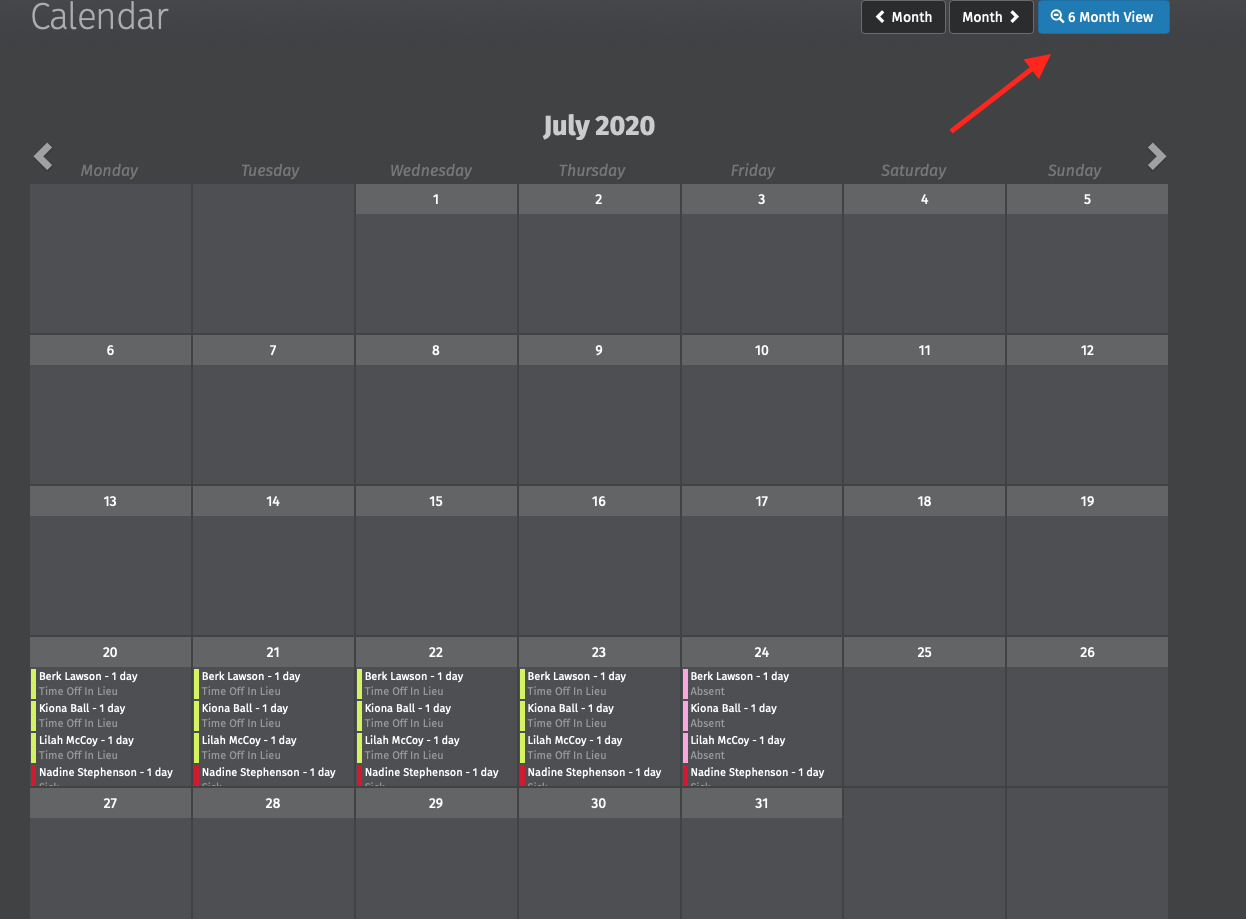
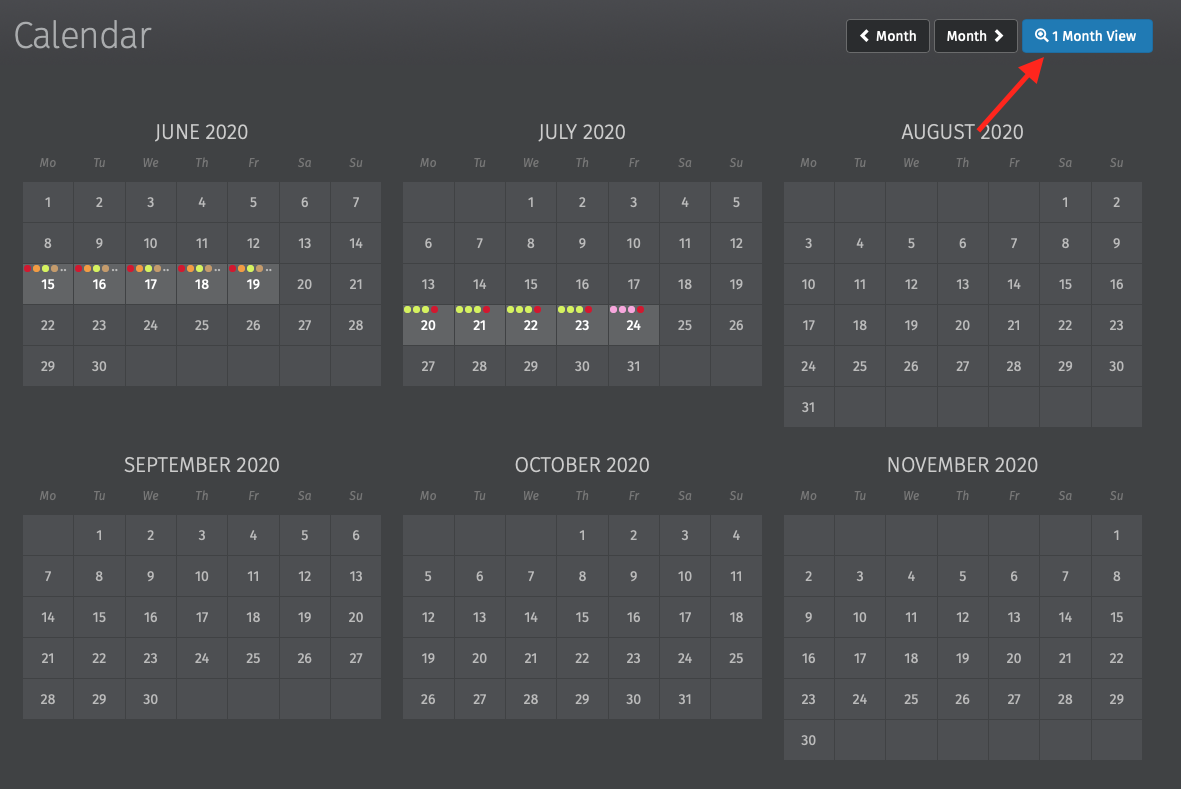
Dates with multiple types of events are dotted with the relevant colours. To see the breakdown, simply hover your mouse over the date. By selecting a date on the calendar a dialog box will open to show all the entries on that date without having to scroll.
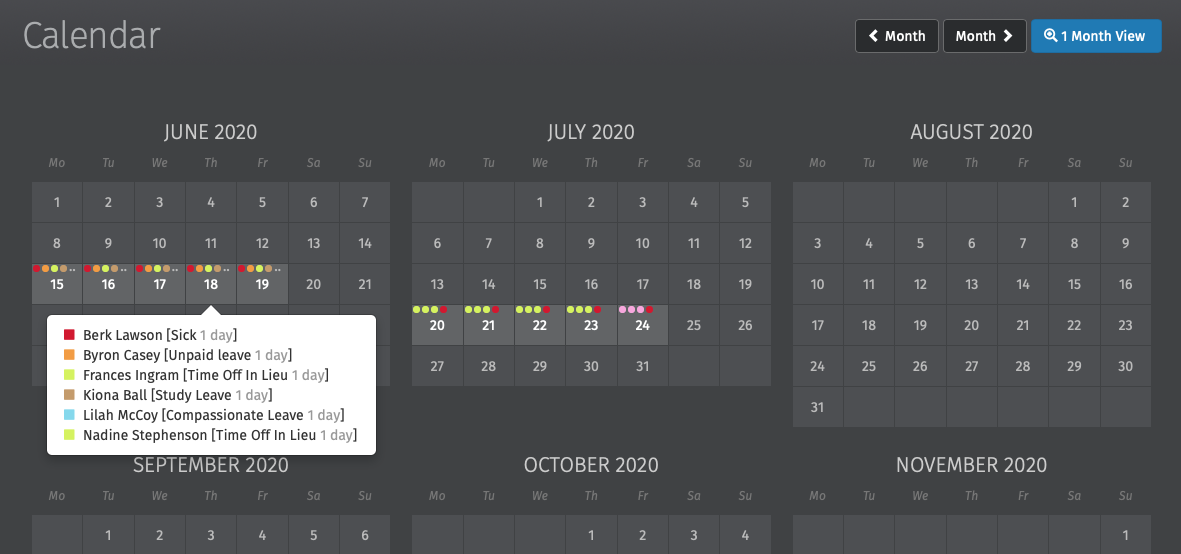
Custom Leave Types
Custom leave types are now available in BrightPay Connect. In BrightPay 2020/21 you can define nine additional custom leave types for employees. Six of the custom leave types are set up with default descriptions such as time in lieu and study leave. Instructions on how to add, edit or remove these custom leave types can be found here.
When a custom leave type is entered on the employee’s calendar in BrightPay and synchronised to Connect the leave type will be displayed on the calendar for both the employer and the employee to view on their online portal or mobile app. Custom leave can only be entered on an employee’s calendar by a user in Connect or on the employee’s calendar in the BrightPay employer file. Employees cannot request any custom leave types.
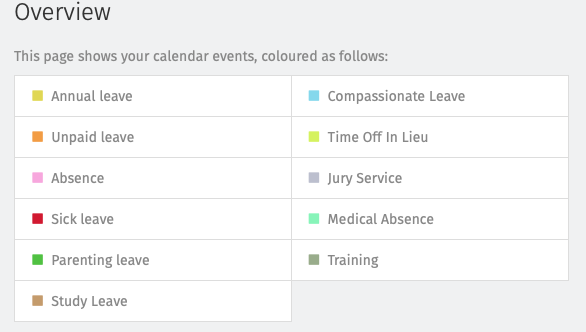
Adding/Requesting Leave
When employers are adding leave on an employee’s calendar in Connect or an employee is requesting leave, they are now entered as date ranges simplifying leave dates being selected. If the employer or an employee enter in an invalid date range (e.g. including non-working days in the date range) it will automatically correct this and only working days will be included in the request.
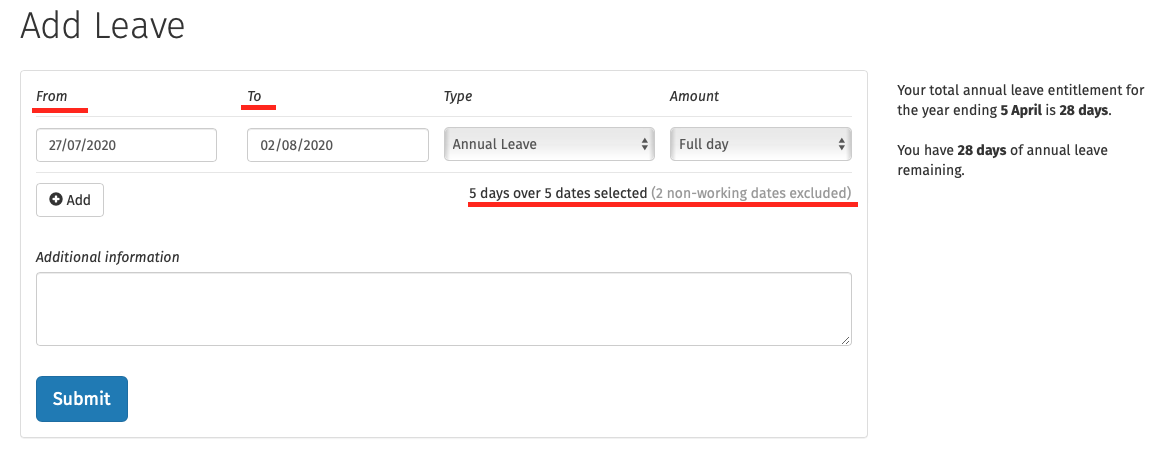
Interested in finding out more about how BrightPay Connect can streamline your leave management processes? Book an online demo of BrightPay Connect today.
Nov 2017
28
The benefits of offering cloud payroll services
Accounting firms and payroll bureaus are increasingly moving into the cloud to offer clients a more flexible and streamlined payroll service. Many believe that payroll isn’t a profitable service due to the complexity of the work, the manual administrative time required and the increasing number of mistakes when it comes to recording employee leave.
The actual process of running payroll is straightforward enough due to easy to use features in payroll software. But what about the administrative payroll and HR related tasks such as processing & sending payslips, managing & recording employee leave, lost payslips, backing up your payroll data, sending payroll reports to clients and updating employee records? All of these tasks can take a considerable amount of managerial time to process and correct where errors have occurred.
The payroll landscape is changing and many payroll bureaus are offering clients a certain level of cloud functionality that automates otherwise time consuming tasks. Online access to payroll information for your clients and their employees offers significant benefits for today's bureau which can will streamline many workforce management tasks.
Cloud Backup
Storing payroll information and data protection continues to be a challenge for payroll bureaus. With an automated cloud backup tool you will never lose your payroll data again. You don’t need to worry about manually backing up your payroll data. Where you payroll software is integrated with the cloud, your payroll data will synchronised to the cloud as you run your payroll or make any changes whilst maintaining a chronological history of your backups. You can restore or download any of the backups to your PC or Mac at any time.
Eliminate Paper & Postage Processing
The concept of a paper payslips that need to be downloaded and emailed or printed, enveloped and then posted in an outdated process. More and more, employees want their payslips to be accessible and securely stored online. Payslips and other payslips related documents such as P60’s, P45’s and employment contracts can be easily accessible on an employee self service online portal. With the cloud, payroll bureaus can avoid spending time printing, emailing and resending lost documents to employees. An online employee self service option allows employees to view current and historic payslips and access all HR employee documents.
Online 24/7 Accessibility
A cloud client and employee dashboard provides 24/7 flexibility and control of payroll information. Clients can access all employees payslips, payroll reports, amounts due to HMRC, employee contact details and can even approve annual leave requests. Employees can access their self service portal on their computer or via a mobile app to view and download payslips, easily submit holiday requests and view leave taken and leave remaining.
Increased Bureau Productivity
Cloud functionality allows for many payroll related tasks to be synchronized with your payroll software. Payroll bureaus radically save time as they no longer need to send payslips to employees, send payroll reports to clients, re-send lost payslips or manually process employee leave on the payroll software.
Annual Leave Management Tool
Annual leave approvals can be approved in the cloud and automatically recorded on your payroll software reducing errors and ensuring leave data is up to date at all times. Clients can view a company wide online calendar where they can easily approve leave while managing staff availability for their business. Employees can benefit as a cloud portal will calculate accurate leave balances in real time. Senior managers and supervisors can be given a high level access to approve holiday requests.
Full integration with payroll software
Payroll software systems that offer a fully integration with the cloud is a must. Integrated payroll and cloud allows both tools in share and synchronise your payroll data in real time. An online payroll tool that links to clients data that is saved on your payroll software can directly communicate with each other ensuring all information is current and correct.
Embrace cloud payroll functionality
Using the cloud to automate many daily payroll and HR related tasks will improve efficiencies for payroll bureaus, employers/clients and their employees. BrightPay Connect is one such cloud solution that fully integrate with BrightPay Payroll offering:
- Automatic cloud backup
- Bureau / Client online dashboard
- Online payroll reporting
- Employee self service
- Online leave management
- Safely store HR documents online
- Update employee details
- Affordability with discounts for multiple purchases
- Easy of Use
Related guides / articles
BrightPay Connect - Guide to Profit for Accountants
Benefits of BrightPay Connect for Bureaus



